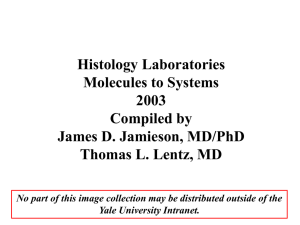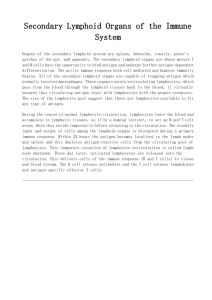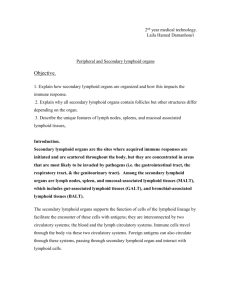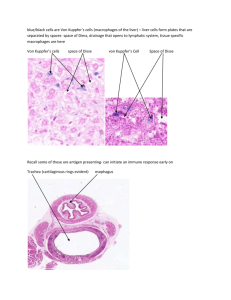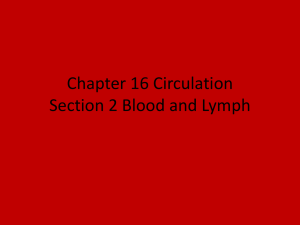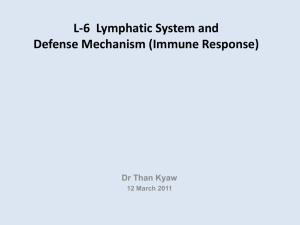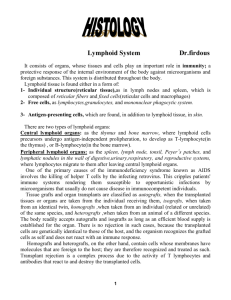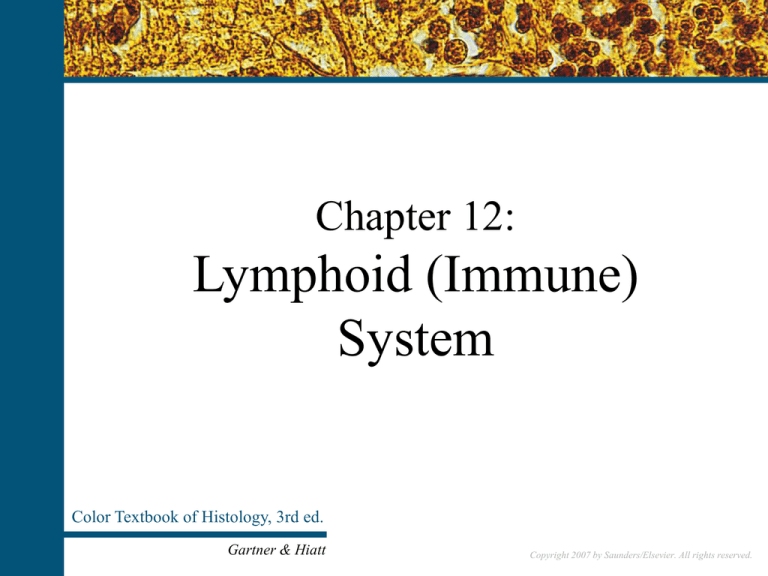
Chapter 12:
Lymphoid (Immune)
System
Color Textbook of Histology, 3rd ed.
Gartner & Hiatt
Copyright 2007 by Saunders/Elsevier. All rights reserved.
Copyright 2007 by Saunders/Elsevier. All rights reserved.
Immune System and Antibody
The lymphoid system is responsible for the immunological defense of the
body. Some of its component organs—lymph nodes, thymus, and
spleen—are bound by connective tissue capsules, whereas its other
components, members of the diffuse lymphoid system, are not
encapsulated. The cells of the lymphoid system protect the body against
foreign macromolecules, viruses, bacteria, and other invasive
microorganisms, and they kill virally transformed cells.
The innate immune system is nonspecific and is composed of (1) a system
of blood-borne macromolecules known as complement; (2) macrophages
and neutrophils, which phagocytose invaders; (3) and natural killer cells
(NK cells), which kill tumor cells, virally infected cells, bacteria, and
parasites.
The adaptive immune system eliminates threats from specific invaders. It
not only reacts against one specific antigenic component of a pathogen but
its ability to react against that particular component improves with
subsequent confrontations with it.
The adaptive immune response exhibits four distinctive properties:
specificity, diversity, memory, and self/nonself recognition—that is, the
ability to distinguish between structures that belong to the organism, self,
and those that are foreign, nonself. T lymphocytes, B lymphocytes, and
antigen-presenting cells (APCs) initiate and participate in the (adaptive)
immune response. These cells communicate with each other by signaling
molecules (cytokines), which are released in response to encounters with
foreign substances called antigens.
Figure 12–1 An antibody and its regions.
Recognition of a foreign substance stimulates a complex sequence of
reactions that result either in the production of antibodies, which bind to
the antigen, or in the induction of a group of cells that specialize in killing
the foreign cell or altered self-cell (e.g., tumor cell). The immune response
that depends on the formation of antibodies is called the humoral immune
response, whereas the cytotoxic response is known as the cell-mediated
immune response.
For more information see Overview of the Immune System in Chapter 12 of Gartner and
Hiatt: Color Textbook of Histology, 3rd ed. Philadelphia, W.B. Saunders, 2007.
Copyright 2007 by Saunders/Elsevier. All rights reserved.
Thymus
The thymus, situated in the superior mediastinum and extending
over the great vessels of the heart, is a small encapsulated organ
composed of two lobes each having a cortex and a medulla.
Immunologically incompetent T cells leave the bone marrow and
migrate to the periphery of the thymic cortex, where they undergo
extensive proliferation and instruction to become
immunocompetent T cells. In addition to the lymphocytes, the
cortex houses macrophages and epithelial reticular cells. 98% of
developing T cells die in the cortex and are phagocytosed by
resident macrophages. Surviving T cells enter the medulla of the
thymus as naive T lymphocytes and from there they are distributed
to secondary lymphoid organs via the vascular system.
The thymic medulla stains much lighter than the cortex, because
its lymphocyte population is not nearly as profuse and because it
houses three types (Types IV, V, and VI) of endothelially derived
epithelial reticular cells. Type VI epithelial reticular cells form the
most characteristic feature of the thymic medulla. These large,
pale-staining cells coalesce around each other, forming whorlshaped thymic corpuscles (Hassall’s corpuscles), whose function
is not known but their numbers increase with a person’s age.
For more information see Thymus in Chapter 12 of Gartner and Hiatt: Color
Textbook of Histology, 3rd ed. Philadelphia, W.B. Saunders, 2007.
Figure 12–5 Diagram of the thymus demonstrating its blood supply and histological
arrangement.
Copyright 2007 by Saunders/Elsevier. All rights reserved.
Lymph Node
Lymph nodes are small, encapsulated, oval structures with a
fibrous connective tissue capsule, usually surrounded by
adipose tissue. Afferent lymph vessels bring lymph into the
substance of the node at its convex surface. At the concave
surface of the node, the hilum, arteries and veins entering and
exiting the node. Lymph leaves the node via the efferent
lymph vessels at the hilum. Histologically, a lymph node is
subdivided into three regions: cortex, paracortex, and
medulla. All three regions have a rich supply of sinusoids
through which lymph percolates.
The cortex of the lymph node is subdivided into
compartments that house B-cell–rich primary and secondary
lymphoid nodules.
Antigen presenting cells migrate to the paracortex of the
lymph node to present their epitope–MHC II complex to T
helper cells. If T helper cells become activated, newly formed
T cells then migrate to the medullary sinuses, leave the lymph
node, and proceed to the area of antigenic activity.
The medulla houses medullary cords and sinuses, as well as
trabeculae bearing vascular supply to the node. Cells of the
medullary cords are enmeshed in a network of reticular fibers
and reticular cells. The lymphocytes from the cortex and
paracortex migrate to the medullary sinuses from which they
enter the efferent lymphatic vessels to leave the lymph node.
Figure 12–7 A typical lymph node.
Copyright 2007 by Saunders/Elsevier. All rights reserved.
For more information see Lymph Nodes in Chapter 12 of Gartner and
Hiatt: Color Textbook of Histology, 3rd ed. Philadelphia, W.B. Saunders,
2007.
Spleen
The spleen, the largest lymphoid organ in the body, with
a dense, irregular fibroelastic connective tissue capsule,
functions not only in the immunological capacity of
antibody formation and T-cell and B-cell proliferation but
also as a filter of the blood in destroying old erythrocytes.
The spleen has a convex surface as well as a concave
aspect, which is known as the hilum, and it is here that
arteries enter and veins and lymph vessels leave the
spleen.
The trabeculae, arising from the capsule, carry blood
vessels into and out of the parenchyma of the spleen.
Histologically, the spleen has a three-dimensional
network of reticular fibers that form the architectural
framework of this organ.
The interstices of the reticular tissue network are
occupied by venous sinuses, trabeculae conveying blood
vessels, and the splenic parenchyma. The cut surface of a
fresh spleen shows gray areas surrounded by red areas;
the former are called white pulp, and the latter are known
as red pulp. Central to the appreciation of the
organization and function of the spleen is an
understanding of its blood supply.
For more information see Spleen in Chapter 12 of Gartner and Hiatt:
Color Textbook of Histology, 3rd ed. Philadelphia, W.B. Saunders,
2007.
Figure 12–10 Schematic diagram of the spleen. Top, Low-magnification view of white pulp
and red pulp. Bottom, Higher-magnification view of the central arteriole and its branches.
Copyright 2007 by Saunders/Elsevier. All rights reserved.
Spleen (cont.)
When the trabecular arteries are reduced to about 0.2 mm in
diameter, they leave the trabeculae. The tunica adventitia of these
vessels become loosely organized, and they become infiltrated by
a sheath of lymphocytes, the periarterial lymphatic sheath
(PALS). Because the vessel occupies the center of the PALS, it is
called the central artery.
At its termination, the central artery loses its lymphatic sheath and
subdivides into several short, parallel branches, known as
penicillar arteries, which enter the red pulp. The penicillar
arteries have three regions: (1) the pulp arteriole, (2) the
sheathed arteriole (a thickened region of the vessel surrounded
by a sheath of macrophages, the Schweigger-Seidel sheath), and
(3) the terminal arterial capillaries.
Terminal arterial capillaries deliver their blood into the splenic
sinuses, giving rise to three theories of circulation in the spleen:
(1) closed circulation, (2) open circulation, and (3) a combination
of the two theories.
The structure of the white pulp is closely associated with the
central arteriole. The PALS that surrounds the central arteriole is
composed of T lymphocytes. Frequently, enclosed within the
PALS are lymphoid nodules, which are composed of B cells.
Lymphoid nodules may display germinal centers, indicative of
antigenic challenge The PALS and lymphoid nodules constitute
the white pulp, and as in the lymph node, the T and B cells are
stationed in specific locations. The white pulp is separated from
the red pulp by the marginal zone composed of plasma cells, T
and B lymphocytes, macrophages, and APCs.
Figure 12–10 Schematic diagram of the spleen. Top, Low-magnification view of white pulp
and red pulp. Bottom, Higher-magnification view of the central arteriole and its branches.
The red pulp of the spleen is composed of splenic sinuses and
splenic cords (of Billroth). It is in these sinusoids that blood is
filtered and old RBCs are destroyed.
For more information see Spleen in Chapter 12 of Gartner and Hiatt: Color
Textbook of Histology, 3rd ed. Philadelphia, W.B. Saunders, 2007.
Copyright 2007 by Saunders/Elsevier. All rights reserved.

